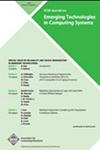基于快速目标检测的PCB x射线CT图像通孔建模框架
IF 2.6
4区 计算机科学
Q3 COMPUTER SCIENCE, HARDWARE & ARCHITECTURE
引用次数: 0
摘要
对于成功的印刷电路板(PCB)逆向工程(RE),所得到的器件必须保留原始器件的物理特性和功能。虽然可再生能源的应用在执行方的自由裁量权范围内,但对于PCB行业的任何利益相关者来说,建立一个可行的、非破坏性的分析框架至关重要。PCB RE中广泛采用的一种方法是使用非破坏性x射线计算机断层扫描(CT)产生三维体积,其中包含多层PCB对应的若干数据切片。然而,x射线CT特有的噪声源和设计人员的可变性阻碍了成功的RE所需的特征的全面获取。本文研究了一种深度学习方法,作为当前最先进的检测PCB x射线CT图像上过孔的继任者;过孔是PCB设计的关键组成部分。在RE过程中,通孔提供了对PCB跨多层电气连接的理解。我们的方法是对早期迭代的改进,它展示了明显更快的运行时间,结果质量与当前最先进的、无监督迭代的基于hough的方法相当或更好。与基于hough的方法相比,当前框架在离散图像场景下的速度快4.5倍,在体积图像场景下的速度快24.1倍。对先前深度学习版本的升级包括更快的基于特征的检测,以满足现实世界的可用性,以及自适应后处理方法,以提高检测质量。本文章由计算机程序翻译,如有差异,请以英文原文为准。
A Fast Object Detection-Based Framework for Via Modeling on PCB X-Ray CT Images
For successful printed circuit board (PCB) reverse engineering (RE), the resulting device must retain the physical characteristics and functionality of the original. Although the applications of RE are within the discretion of the executing party, establishing a viable, non-destructive framework for analysis is vital for any stakeholder in the PCB industry. A widely-regarded approach in PCB RE uses non-destructive x-ray computed tomography (CT) to produce three-dimensional volumes with several slices of data corresponding to multi-layered PCBs. However, the noise sources specific to x-ray CT and variability from designers hampers the thorough acquisition of features necessary for successful RE. This article investigates a deep learning approach as a successor to the current state-of-the-art for detecting vias on PCB x-ray CT images; vias are a key building block of PCB designs. During RE, vias offer an understanding of the PCB’s electrical connections across multiple layers. Our method is an improvement on an earlier iteration which demonstrates significantly faster runtime with quality of results comparable to or better than the current state-of-the-art, unsupervised iterative Hough-based method. Compared with the Hough-based method, the current framework is 4.5 times faster for the discrete image scenario and 24.1 times faster for the volumetric image scenario. The upgrades to the prior deep learning version include faster feature-based detection for real-world usability and adaptive post-processing methods to improve the quality of detections.
求助全文
通过发布文献求助,成功后即可免费获取论文全文。
去求助
来源期刊
CiteScore
4.80
自引率
4.50%
发文量
86
审稿时长
3 months
期刊介绍:
The Journal of Emerging Technologies in Computing Systems invites submissions of original technical papers describing research and development in emerging technologies in computing systems. Major economic and technical challenges are expected to impede the continued scaling of semiconductor devices. This has resulted in the search for alternate mechanical, biological/biochemical, nanoscale electronic, asynchronous and quantum computing and sensor technologies. As the underlying nanotechnologies continue to evolve in the labs of chemists, physicists, and biologists, it has become imperative for computer scientists and engineers to translate the potential of the basic building blocks (analogous to the transistor) emerging from these labs into information systems. Their design will face multiple challenges ranging from the inherent (un)reliability due to the self-assembly nature of the fabrication processes for nanotechnologies, from the complexity due to the sheer volume of nanodevices that will have to be integrated for complex functionality, and from the need to integrate these new nanotechnologies with silicon devices in the same system.
The journal provides comprehensive coverage of innovative work in the specification, design analysis, simulation, verification, testing, and evaluation of computing systems constructed out of emerging technologies and advanced semiconductors

 求助内容:
求助内容: 应助结果提醒方式:
应助结果提醒方式:


